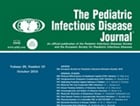Abstract and Introduction
Abstract
Background: Kawasaki disease (KD) is a multisystemic vasculitis primarily affecting children <5 years. A review of RotaTeq (rotavirus vaccine live) clinical trial data revealed higher, though not statistically significantly, KD rates among RotaTeq vaccines than placebo recipients. In June 2007, the RotaTeq label was revised accordingly.
Objectives: To describe and assess KD reported to Vaccine Adverse Event Reporting System (VAERS) for all US licensed vaccines.
Methods: We reviewed all KD reports received by VAERS from 1990 through mid-October 2007. Cases were characterized by age, gender, onset interval, and vaccine type. Proportional reporting ratio (PRR) was used to evaluate KD reporting for each vaccine compared with all others. Reporting rates were calculated using number of doses distributed as denominator.
Results: Through October 14, 2007, 107 KD reports were received by VAERS: 26 were categorized as classic cases, 19 atypical, 52 possible, and 10 were noncases. Of the 97 cases, 91% were children <5 years. There was no clustering of onset intervals after day 1 postvaccination. Before the RotaTeq label revision, the KD PRR was elevated only for Pediarix (DTaP, hepB, and IPV combined) but the KD reporting rate for Pediarix (0.59/100,000 person-years) was much lower than the background incidence rate (9–19/100,000 person-years) for children <5 years in the United States. After the revision, reporting of KD for RotaTeq was stimulated but the reporting rate for RotaTeq (1.47/100,000 person-years) was still much lower than the background rate.
Conclusions: Our review does not suggest an elevated KD risk for RotaTeq or other vaccines. Continued postmarketing monitoring for KD is ongoing.
Introduction
Kawasaki disease (KD) is an acute, multisystemic vasculitis, manifested by a constellation of signs and symptoms, including fever, rash, conjunctival injections, cervical lymphadenopathy, oral mucosal changes, and characteristic extremity changes.[1,2] Epidemiologic data suggest that the disease occurs worldwide in individuals of all races, with the highest incidence in Japan and in persons of Asian ethnicity.[3–6] Children <5 years of age are primarily affected, and the disease is more common in males.[2,7] Approximately 20% of untreated patients and 4% of treated patients develop coronary artery dilatation and aneurysm.[3,4] KD is now the leading cause of acquired heart disease in children in the United States.[3]
In the United States, the KD incidence in children aged <18 years was estimated to be 6.4 per 100,000 person-years in 1997 and 5.9 per 100,000 person-years in 2000.[8] In children <5 years of age, the incidence was approximately 9 to 19 per 100,000 person-years during 1993–1996.[5] Using hospitalization data from the Kids' Inpatient Database, a large national all-payer hospital pediatric discharge database weighted to generate nationwide estimates, the KD incidence in the year 2000 among children <5 years of age was 17 per 100,000 children.[8]
The etiology of KD is unclear. Based on clinical and epidemiologic features, an infectious etiology is strongly suspected; in addition, because of the widely varying frequencies in different racial and ethnic groups, a genetic component is likely.[9–13] In a 1983 study of a cohort of KD patients admitted to 3 Tokyo hospitals, Matsuno et al[14] reported finding rotavirus viral shedding in 74% of KD patients versus 11% of control patients, while rotavirus antibody titers were increased in 51% of KD patients versus 8% of controls. These findings have not been investigated in any subsequent published studies. Recent studies suggest a respiratory portal of entry of the suspected pathogen, although no infectious agent has been etiologically associated with the disease.[9]
KD can occur in a temporal relationship with vaccination, but a causal association has not been established. One case of KD in a 35-day-old infant 1 day after hepatitis B vaccination in Israel has been described.[15] In a matched case-control study during a KD outbreak from November 1997 through April 1998 in Colorado involving 19 cases and 38 controls, Treadwell et al found no association between KD and vaccination during the 30 days before disease onset.[16] In prelicensure clinical trials of the recently licensed RotaTeq (rotavirus vaccine, live, oral, pentavalent; Merck & Co., Inc., Whitehouse Station, NJ), a live oral pentavalent rotavirus vaccine, a discrepancy in the number of KD cases was noted between RotaTeq and placebo. A total of 6 KD cases were identified: 5 among 36,150 vaccine recipients and 1 among 35,536 placebo recipients, with a crude relative risk of 4.9 (95% CI: 0.6–239.1),[17] all 5 cases after RotaTeq occurred within 30 days after vaccination. Although the finding was not statistically significant, and there was no clustering by age, gender, time to onset, dose number, or concomitant vaccinations,[17] the manufacturer revised the RotaTeq label by adding KD to the Serious Adverse Events section. The label revision was approved by the US Food and Drug Administration (FDA) and published on June 15, 2007.
To further evaluate the issue raised by the RotaTeq vaccine clinical trials about the possibility of an association between vaccines and KD, we systematically reviewed all KD reports received by the Vaccine Adverse Event Reporting System (VAERS) for all US licensed vaccines since 1990.
Pediatr Infect Dis J. 2009;28(11):944-947. © 2009 Lippincott Williams & Wilkins
Cite this: Kawasaki Disease After Vaccination: Reports to the Vaccine Adverse Event Reporting System 1990-2007 - Medscape - Nov 01, 2009.





Comments